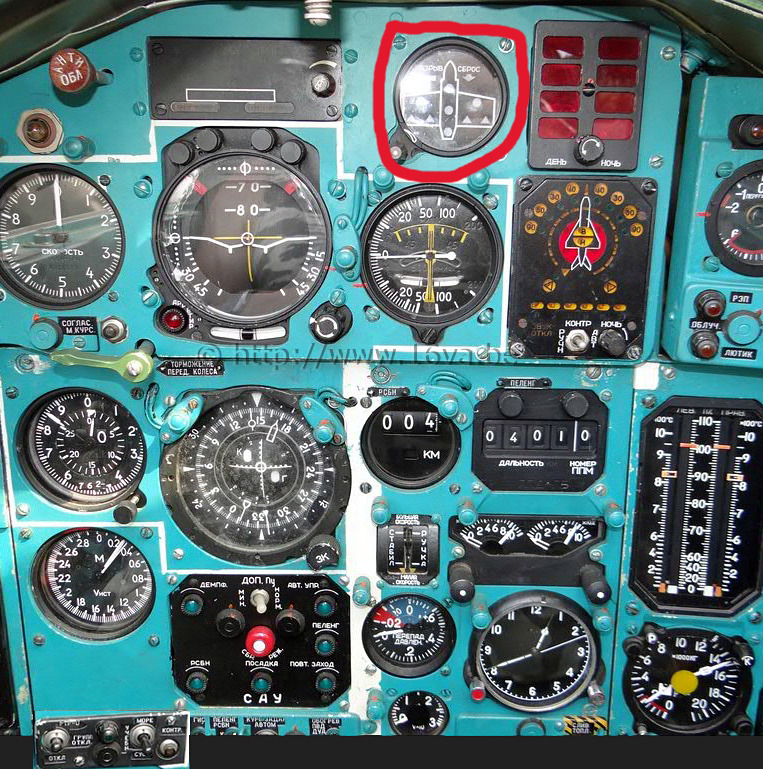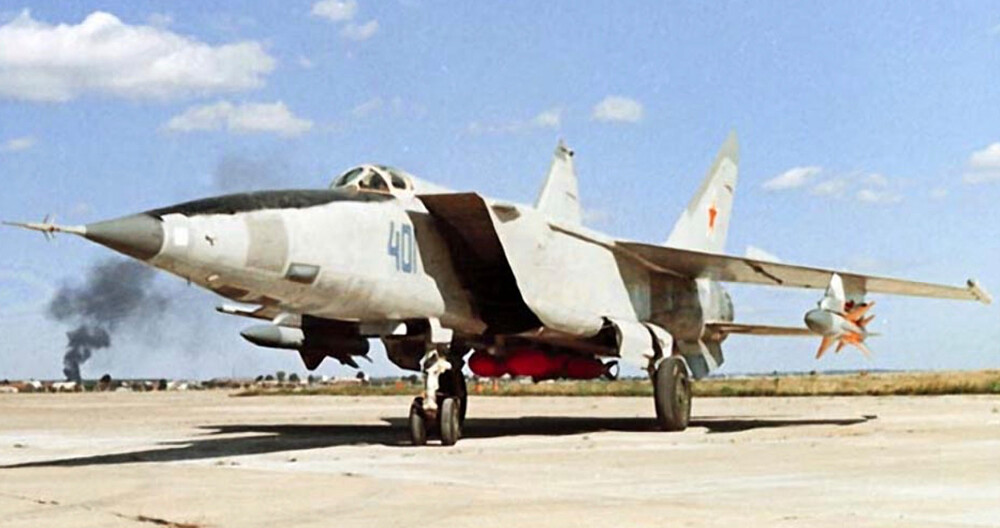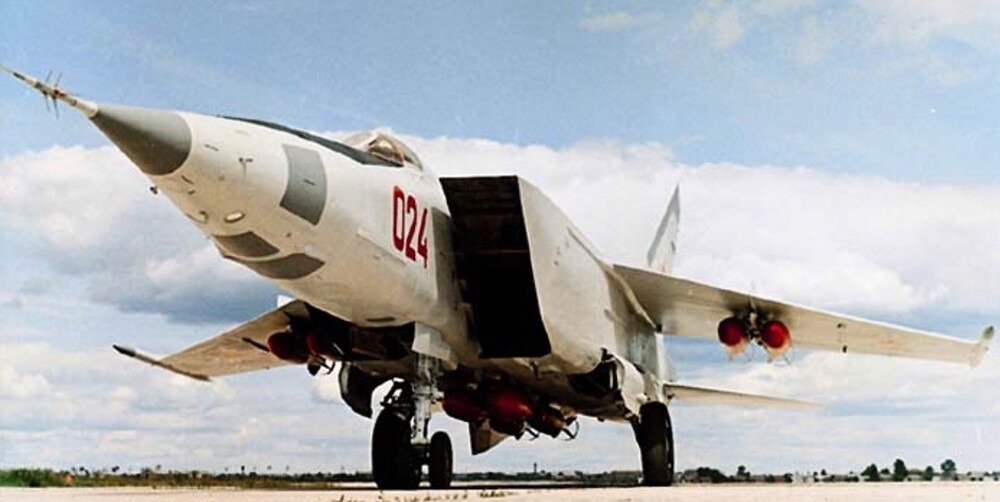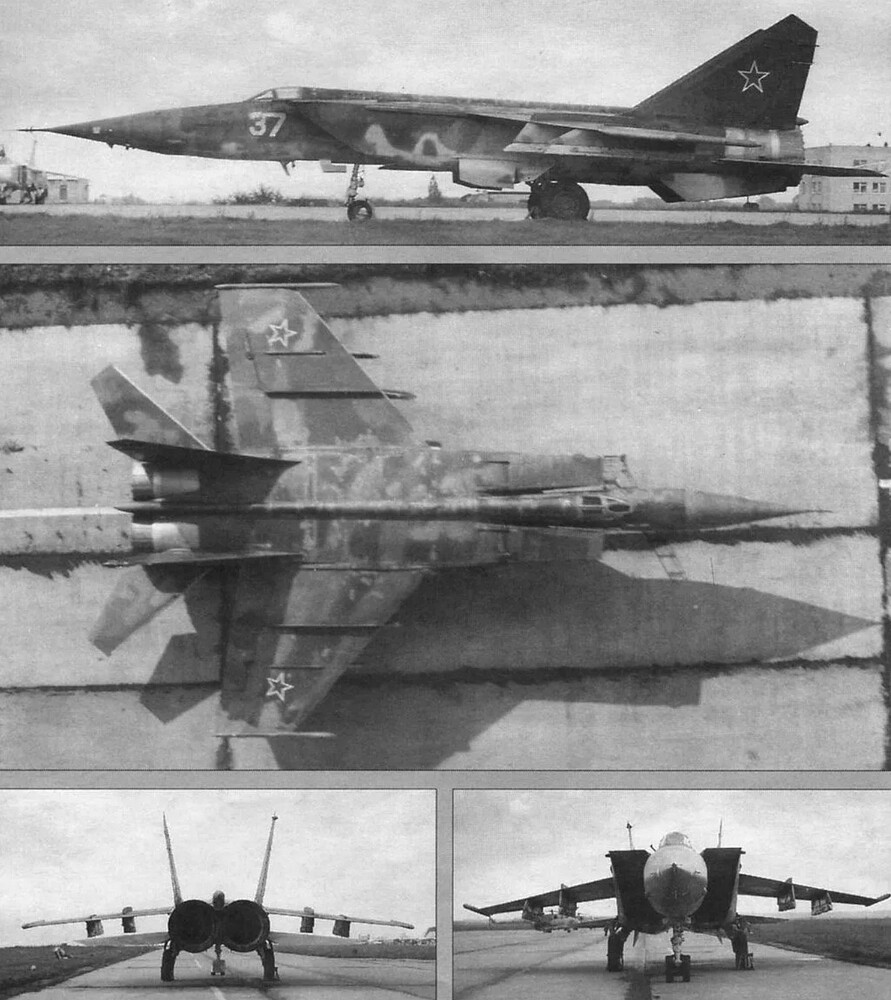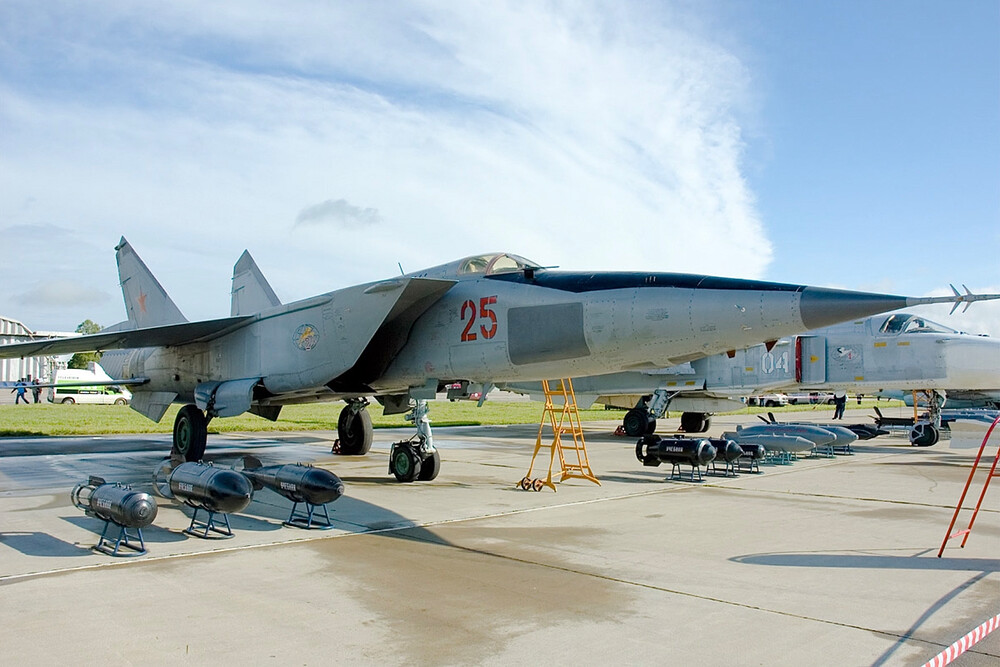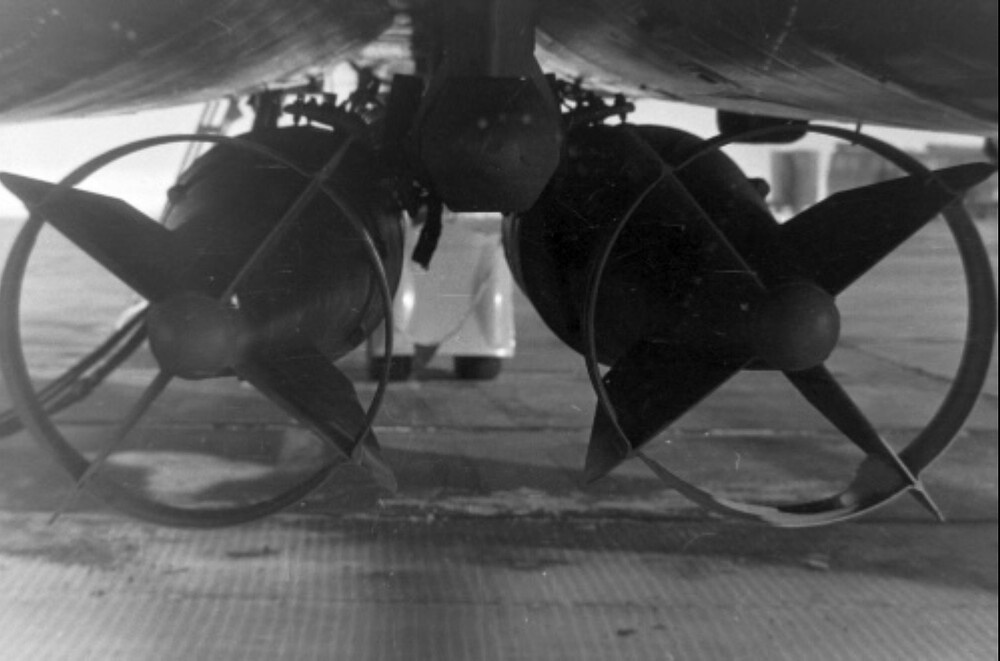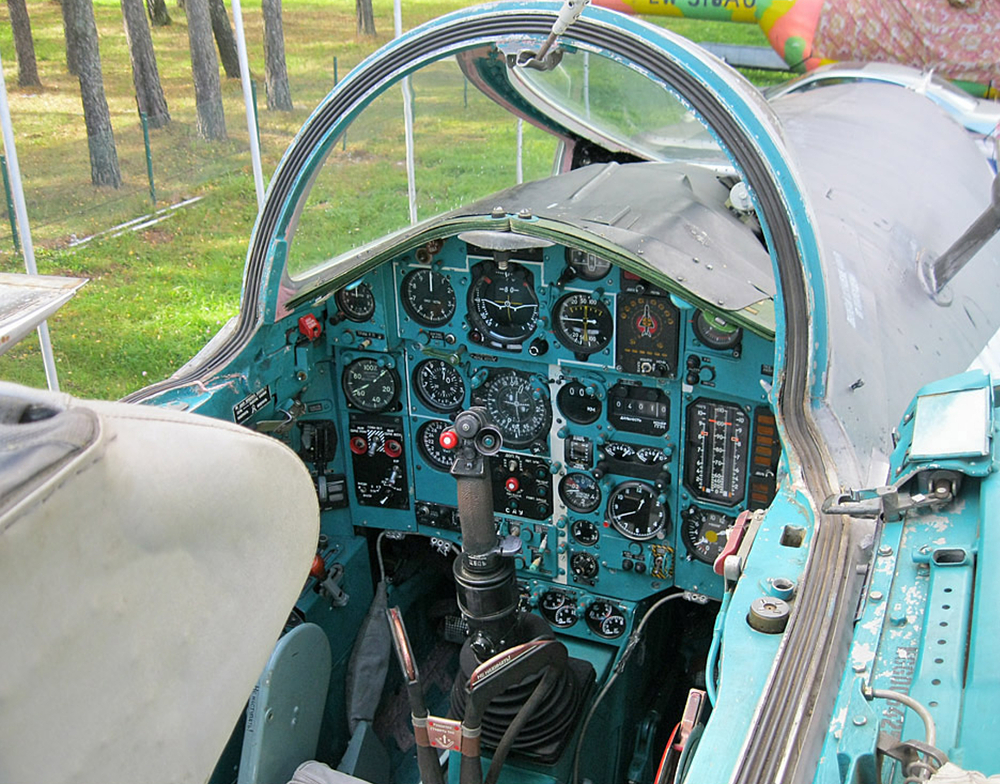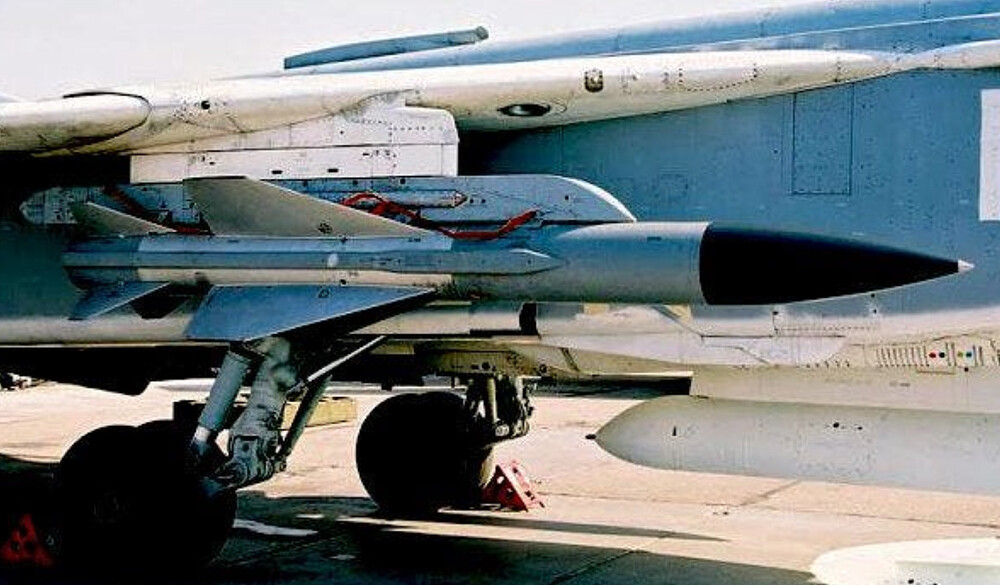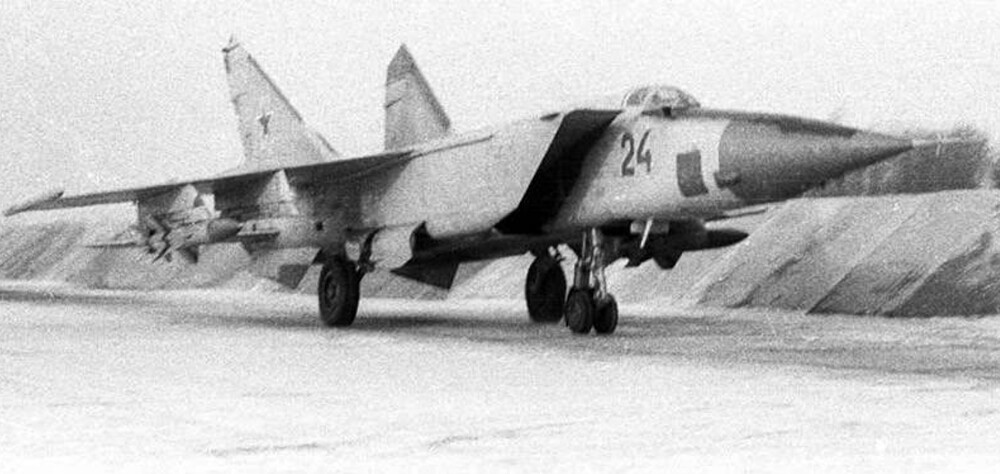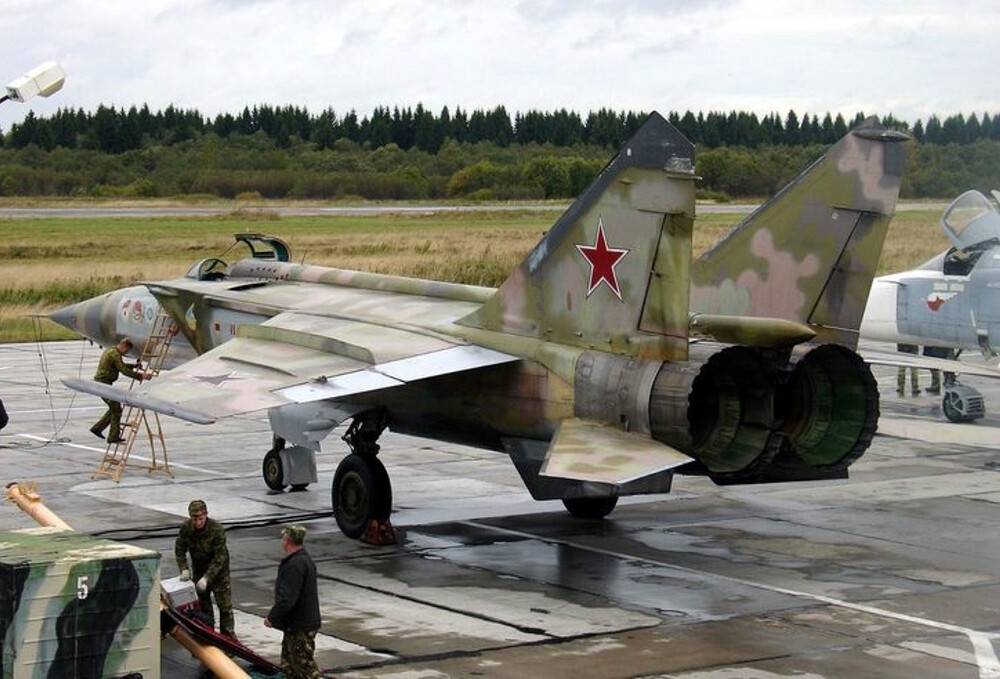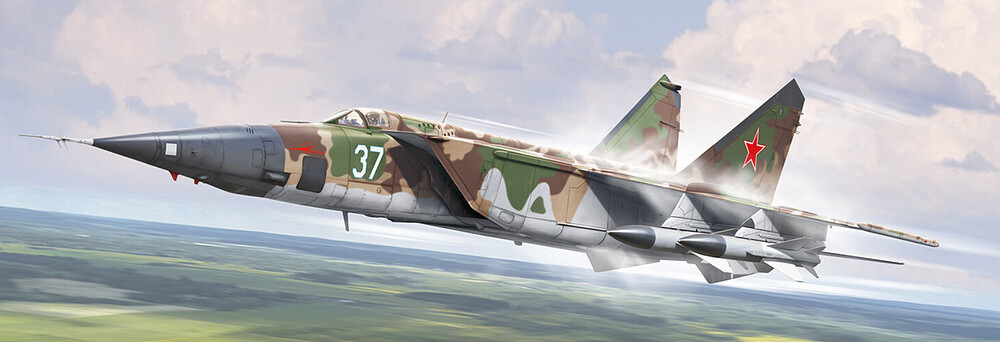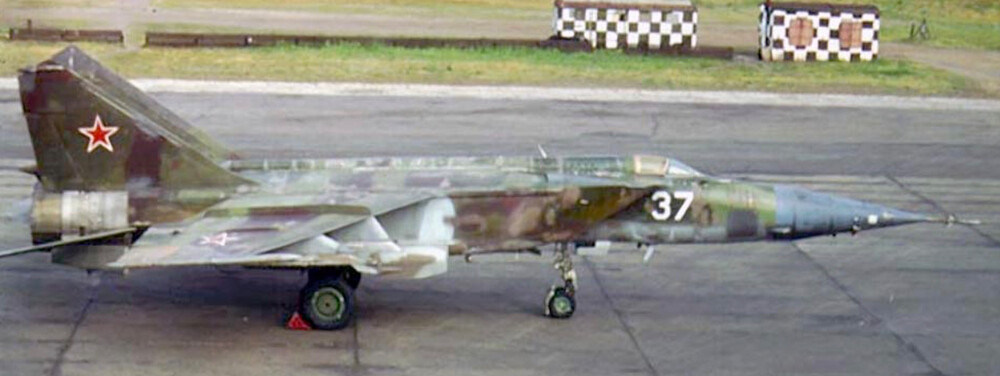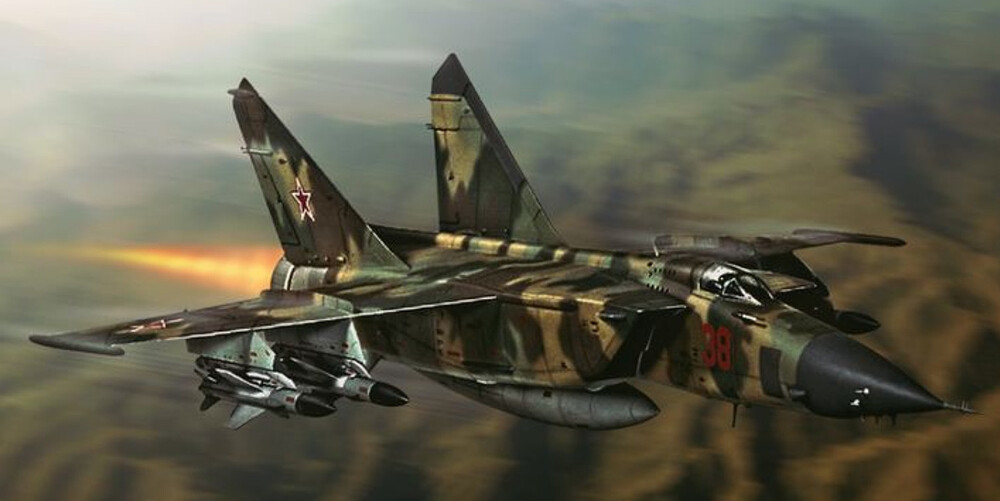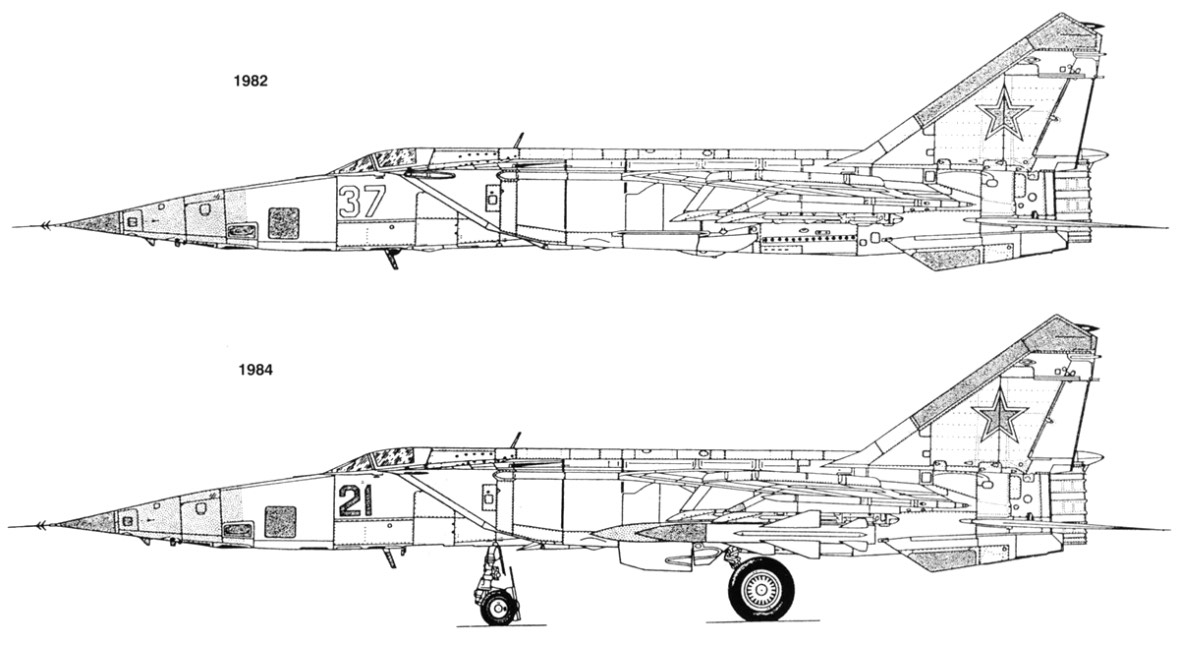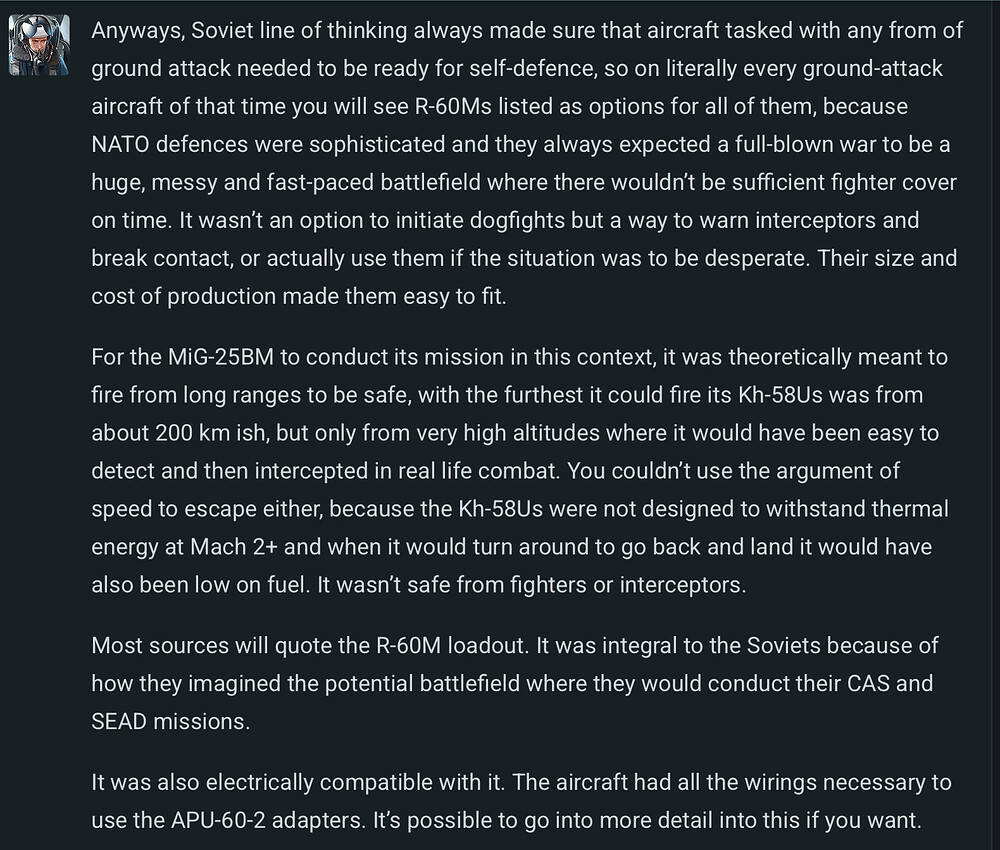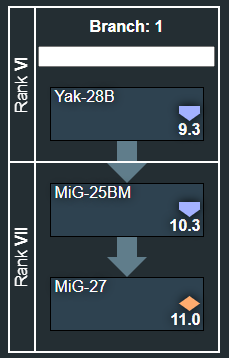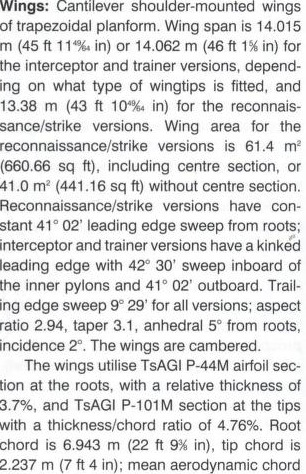Would you like to see MiG-25BM in-game?
- As a Premium Vehicle
- As an Event Vehicle
- As a Squadron Vehicle
- As a Tech-Tree Vehicle
- I said No
MiG-25BM “Foxbat-F”
Introduction
The
MiG-25BM was the Soviet Union’s dedicated
Suppression of Enemy Air Defenses (SEAD) variant of the famous Foxbat platform, developed to eliminate NATO surface-to-air missile systems, using
Kh-58U (AS-11 Kilter), from high altitude and at high speed. It combined the raw engine performance of the
MiG-25PD interceptor with the ground-attack flexibility of the MiG-25RB series, offering a potent strike platform capable of operating deep into enemy airspace while evading or neutralizing radar threats.
Importantly, this jet could carry FAB-250M/500M-62T unguided bombs and R-60 series IR-guided missiles, which is why I’m making this suggestion, even while acknowledging that, at the time of writing, SEAD is not currently a feature in War Thunder. I’m simply proposing a MiG-25 that represents the RB family as a whole, so that Gaijin doesn’t add multiple separate variants.
Most MiG-25RB bombers historically lacked air-to-air missile capability, which would make them relatively limited and unengaging to play in War Thunder. In contrast, the MiG-25BM not only retained its full bombing capability, but also gained the ability to engage enemy aircraft with R-60 missiles and suppress enemy radar stations using dedicated SEAD missiles. As an RB-series variant, it also had been equipped with electronic countermeasures, a feature not even found on the MiG-25PD.
Design & History
Spoiler
The MiG‑25R series originated in the 1960s, when the Soviet Union sought a high-speed, high-altitude reconnaissance platform to match its interceptor cousin, the MiG‑25P. The initial MiG‑25R model was designed purely for strategic photographic and electronic reconnaissance, exploiting its ability to fly over Mach 2.8 at altitudes exceeding 20 km to evade interception. It carried sophisticated cameras and basic ELINT equipment to survey enemy installations and troop movements deep behind front lines.
Building on this, the
MiG‑25RB variant (
Razvedchik-Bombardirovshchik, or
Reconnaissance-Bomber) was introduced in the early 1970s to add a high-speed bombing capability. It retained the cameras and reconnaissance gear of the MiG‑25R but incorporated a specialized navigation and bombing system that allowed it to release free-fall bombs at very high speeds and altitudes with surprising accuracy for the time. This dual-purpose role made the RB particularly valuable for both strategic reconnaissance and high-risk strike missions against important targets that might be heavily defended.
The MiG‑25RB family spawned several specialized reconnaissance variants, each tailored to specific intelligence-gathering roles.
Special equipment of the reconnaissance-bomber variants:
- Aerial cameras: A-70M, A-E/10, A-72, S-45-ARE, and the NA-75 night camera;
- General electronic reconnaissance stations: SRS-4A, SRS-4B, or SRS-4V (on the MiG-25RB);
- SRS-9 “Virazh” (on the MiG-25RBV);
- “Tangazh” system (on the MiG-25RBT);
- “Kub 3M” electronic intelligence station (on the MiG-25RBK);
- “Sablya” side-looking radar (on the MiG-25RBS), or “Shompol” (on the MiG-25RBSh);
- “Shar-25” electronic reconnaissance station (on the MiG-25RBF).
RB modifications are equipped with the “Peleng-D” targeting and navigation system (or “Peleng-DR” / “Peleng-DM”), which includes:
- the IKS-8 inertial-heading system;
- the DISS-3s “Strela” Doppler drift and slip angle sensor (later replaced by DISS-7 “Poisk”);
- and the TsVM-10-155 “Orbita-155” digital computer.
MiG-25BM
The MiG-25BM is equipped with the “Yaguar” targeting complex, which includes the “Sych-M” detection and target designation system.
The MiG-25BM was specifically derived from the MiG-25RBK. Like its siblings, the BM replaced the interceptor’s radar with specialized systems in the nose designed to detect, track, and engage enemy radar sites. Unlike variants such as the RB or RBSh, the BM did not feature conventional optical cameras or ground-mapping radars, focusing instead on a dedicated SEAD role using anti-radiation missiles and conventional free-fall bombs. Structurally, the MiG-25BM was distinguished (from other RBs) by a nose section extended by 0.72 meters.
Visually and structurally, the MiG-25BM is nearly identical to other aircraft in the MiG-25RB family, with the only notable external differences being found in the nose section, which varied depending on the specific RB variant and the equipment it housed. And naturally, the BM was equipped with underwing pylons to carry the Kh-58 “Kilter” missiles, unlike other RB-series jets which carried either bomb racks or nothing at all.
It should be noted that the MiG-25BM, being part of the RB family, featured a slightly different wing structure compared to the P/PD-series interceptors. Specifically, the RB series had a shorter wingspan of 13.38 meters (compared to 14.06 meters on the P/PD variants) and a wing area of 61.4 square meters. Despite these structural differences, the BM shared the same engine capability with the PD series, offering similar performance in terms of speed and climb rate.
The inner pylons on the BM also differed in design from those on the PD series. However, this difference does not affect bombing capability, since underwing bombs are typically mounted only when these pylons are removed entirely. The outer pylons, by contrast, appear to be identical to those used on the P/PD variants, making them compatible with a range of weapon types. The Kh-58U “Kilter” missiles were carried using special adapter racks, which could be removed and replaced with mounts for other weapons, such as R-60 infrared-guided missiles, depending on the mission profile.
Unlike their interceptor counterparts, which were typically painted in bland finishes optimized for high-altitude operations, the MiG-25RB-series bombers (Including BM) were occasionally seen in distinctive camouflage schemes. These liveries not only reflected the aircraft’s ground-attack and reconnaissance roles over varied terrain but also gave the RB variants a tactical appearance compared to the sterile, high-altitude look of their interceptor brethren.
Armament & Combat Capability
Spoiler
Although best known for carrying Kh-58U (AS-11 Kilter) anti-radiation missiles on dedicated pylons, the MiG-25BM retained the capability to mount standard RB-series bomb pylons, allowing it to carry and use conventional RB-series bombs.
Soviet MiG-25RB bombers typically carried up to 8 × FAB-250M-62T or FAB-500M-62T 500 kg bombs. The FAB bombs used by the MiG-25RB family were specifically engineered to withstand the extreme heat generated during high-speed, high-altitude flight. Their engineering choices allowed them to remain stable under the intense aerodynamic heating experienced at supersonic speeds. However, despite this, the safe operational bombing speed was still limited, as exceeding that could risk damaging bombs or compromising structural integrity during release.
These bombs were typically distributed across four underwing and four under-fuselage hardpoints, forming the standard 8-bomb configuration used by the MiG-25RB family. However, at least one loadout schematic of a MiG-25RBT depicts a configuration with 10 FAB-500M-62T bombs, including six mounted under the fuselage. The Soviets did possess pylon configurations capable of carrying three to six bombs at a time (MBD3-U6-68), allowing for dense ordnance loading on a limited number of hardpoints. However, one source claims that instead of mounting three bombs on a single or two triple pylons, an additional double pylon was installed to accommodate the extra ordnance. This configuration, however, lacks any confirmed photographic or visual evidence to support it. Given the shared structure and hardpoint arrangement between the RBT and the BM, it’s plausible that the MiG-25BM could have also supported this enhanced loadout. It is also said that some RB bombers were equipped with S-24 unguided rockets, although, again, there is no visual evidence of this.
As for the wing-mounted bombs, the RB series employed two mounting configurations: one with two bombs positioned side by side (MBDZ-U2 pylon) on a single pylon, and another more aerodynamically refined setup that staggered the bombs in tandem (MBDZ-U2TK pylon), one behind the other. The latter configuration reduced drag and improved high-speed flight characteristics, particularly during supersonic bombing runs. On the MDZU-U2 pylon, the right bomb was released first, followed by the left. In contrast, on the MDBZ-U2TK tandem pylon, the rear bomb detached first, with the front bomb released afterward.
MiG-25BM Air to Air Capability
In addition to the above mentioned loadouts, the MiG-25BM specifically could carry R-60 infrared-guided missiles for self-defense. The outer pylons on the MiG-25BM are structurally identical to those found on other MiG-25 variants, allowing for standard weapon compatibility. The MiG-25BM has the same SEP-72M PSU and BUP-72 launch control block to use APU-60-2 adapters as the MiG-25PD. As a result, the MiG‑25BM may have also been capable of carrying R‑40T/TD infrared-guided missiles. This gave the aircraft a minimal but effective ability to counter interceptors during high-risk missions near enemy air defense zones. No other RB-series variant was listed as capable of carrying R-60 air-to-air missiles
Notably, there is an indicator in the cockpit that allows the pilot to select between different armament types, including both missiles and bombs. This serves as strong evidence of the MiG-25BM’s capability to carry a mixed loadout of bombs and missiles. This indicator also suggests that the MiG-25BM could carry bombs on its wings, rather than being limited to belly-mounted stores. This implies that it may have been capable of carrying a full, standard RB-series bomb load.
Kh-58U (AS-11 Kilter)
Spoiler
The Kh-58U, known in NATO as AS-11 “Kilter,” is a long-range Soviet anti-radiation missile developed to destroy enemy radar installations as part of SEAD (Suppression of Enemy Air Defenses) operations. Evolving from the earlier Kh-28, it uses solid-fuel propulsion for greater reliability and performance. The Kh-58U variant, introduced around 1991, improved on the original Kh-58 with extended range, up to about 250 km when launched from high altitudes, and better guidance accuracy.
The missile weighs approximately 640 kg, has a length of nearly 4.8 meters, and carries a 149 kg high-explosive warhead designed to disable large radar sites with a single hit. It relies on a two-phase guidance system: inertial navigation guides it during midcourse flight toward the radar’s last known location, while a passive radar seeker activates in the terminal phase to home in on enemy emissions. Capable of speeds exceeding Mach 3.5, the missile can be fired from platforms like the MiG‑25BM, Su‑24M, Su‑22M4, Su‑25TK, and various Su‑30MK versions. It saw early combat use in the late 1980s, notably with Iraqi forces against Iranian Hawk sites, and has since been used in conflicts like the 2008 Russo-Georgian War and the ongoing war in Ukraine, where it has reportedly targeted systems such as Buk and Osa radars.
The MiG-25BM was purpose-built to carry and deploy the Kh-58 (or Kh-58U) anti-radiation missile. Unlike earlier Soviet air-to-radar missile concepts that were extremely heavy, the Kh-58 offered a more practical solution and became the centrepiece of the BM’s offensive capability. The aircraft was fitted with four missiles mounted on AKU-58 launch rails under the wings, and guided using the newly developed “Yaguar” targeting complex. This system included the “Sych-M” passive homing sensor, the “Beryoza-L” ELINT station, and ECM pods such as “Siren-1D-0Zh” and “Lyutik”. During state testing between 1977 and 1980, the Kh-58U demonstrated high accuracy, often hitting its targets even after radar sources were shut off mid-flight. With a launch range exceeding 40 kilometers, the missile proved exceptionally effective.
Combat History & Export
Spoiler
In 1986, several MiG-25BM aircraft were deployed to Iraq for combat trials during the Iran–Iraq War. Operated by Soviet instructors, they tested the new Kh-58U and Kh-31P anti-radiation missiles against Iranian radar and SAM sites. These missions represented the only confirmed combat use of the MiG-25BM that I found. And I could not find any other export customer of the BM. However, the standard MiG-25RB reconnaissance-bomber variants were widely exported.
This is interesting because the source indicates that the MiG-25BM was not limited to the older Kh-58 missile, but also employed the newer Kh-31P. Kh-58 (Kh-58U) anti-radiation missile is a heavy rocket-motor ARM built for high-altitude launch from large platforms with long advertised ranges, whereas the Kh-31P is a later, faster ramjet-powered ARM with newer seeker electronics, shorter practical standoff but much higher speed and better penetration, and greater compatibility with a wider range of tactical fighters.
External Fuel
Spoiler
The MiG-25RB type aircraft (BM included) could be fitted with a massive external fuel tank that carried more fuel than the internal capacity of a MiG-23, significantly extending its operational range without severely compromising its high-speed performance.
Countermeasures
Spoiler
The only confirmed chaff and flare dispensers ever equipped on MiG-25 variants were the BVP-50-60 pods, mounted over the wings. Each pod contained 30 KDS-155 cartridges, providing effective countermeasure coverage. This configuration is clearly visible on this model of an Iraqi MiG-25PD/PDS aircraft. However, in the context of reconnaissance MiG-25s, such systems were reportedly fitted only to the MiG-25RBF. These systems were never put into service as they were deemed redundant, the Soviets considered the aircraft’s speed sufficient for self-defense. There is no visual evidence confirming that the MiG-25BM ever carried chaff/flare dispensers. The decision on whether to add flare and chaff dispensers to the BM ultimately rests with Gaijin.
MiG-25BM Confirmed Countermeasures
In any case, MiG-25BM came equipped with SPO-15 “Beryoza” radar warning receiver, enhancing its situational awareness against enemy radar threats. Some later-production models also featured additional antennas mounted near the engine intake nozzles (as seen on the image above).
The RB (BM included) aircraft were fitted with
electronic countermeasures (ECM):
SPS-141, SPS-142, SPS-143, or
SPS-151.
Speed and electronic countermeasures were the RB series’ primary means of defense against threats.
Specifically the SPS-151 “Siren-1D-OŽ” and SPS-135 “Ljutik” were active radar self-protection jammers carried by the MiG-25BM as part of its defensive electronic warfare suite. Their role was individual aircraft protection: once hostile radars illuminated the aircraft, these systems transmitted jamming signals to disrupt radar tracking, range-finding, and missile guidance. While hunting SAM radars with the Jaguar antiradar complex, Siren-1D-OŽ and Ljutik complemented passive warning and emitter-location systems by actively degrading enemy fire-control radars.
Flight Performance
Spoiler
The MiG-25BM had the powerplant of the MiG-25PD interceptor, however shared the same airframe structure as its RB-series bomber counterparts. It was powered by two Tumansky R-15BD-300 turbojet engines, each generating 11,200 kgf of thrust with afterburner. This gave the aircraft a maximum speed of Mach 2.83 at high altitude, though it was capable of safely exceeding that limit. The BM series could also utilize the R-15BF2-300 turbojets, each rated at approximately 13,000 kilograms-force of thrust with afterburner. However, operational limitations during strike missions typically restricted the aircraft’s maximum speed, in order to avoid overheating or damaging bombs and missiles. R-60 missiles, when carried, were rated for use at speeds up to Mach 2.5 (Although the R-60 missiles used on MiG-25s were reinforced to withstand greater heat and aerodynamic stress).
The RB-series bombers, including the BM, were designed to perform high-speed, high-altitude bombing runs. A typical mission profile involved flying at 2,500 km/h and releasing bombs from an altitude of 20,000 meters. From that height and speed, bombs were released at a stand-off distance of approximately 38.8 kilometers, taking just 76 seconds to reach their target, underscoring the aircraft’s emphasis on survivability through speed and altitude rather than countermeasures or agility.
Contrary to popular belief, flying at Mach 3 and above in the MiG-25 did NOT result in permanent or irreparable engine or airframe damage. Such extreme speeds primarily reduced the service life of the engines and certain airframe components, but did not destroy them outright.
Summary & Implementation
Spoiler
With around 40 aircraft built/converted, the MiG-25BM represents a fascinating and underrepresented branch of Foxbat development. Though it lacked cannons, countermeasures, or dogfighting agility, the MiG-25BM’s unique combination of extreme speed, high-altitude performance, ECM, heavy bomb load, anti-radiation strike capability, and missile-based self-defense made it a far more aggressive, survivable, and proactive strike platform than any standard RB-series reconnaissance bomber.
If implemented, the MiG-25BM should feature a functional third-person ground-attack reticule to support high-speed bombing runs, representing the specialized bombing targeting equipment used with the RB series jets. For self-defense, the aircraft should be equipped with infrared-guided missiles, such as the R-60, to give it a fighting chance against enemy aircraft. The aircraft did not feature chaff and flare dispensers, it instead relied on ECM. Furthermore, once SEAD mechanics are introduced in War Thunder, the MiG-25BM should absolutely receive its historical anti-radiation missile loadouts, to fulfil its intended suppression role. Without these core features, the MiG-25BM would struggle to stand out as a meaningful or competitive addition to the game.
In the end, these decisions are at Gaijin’s discretion.
MiG-25BM “Foxbat-F” – Full Specifications
Spoiler
General Characteristics
- Role: SEAD / High-speed strike and escort suppression aircraft
- Crew: 1 (pilot)
- Length: 22.27 meters
- Wingspan: 13.42 meters
- Height: 6.00 meters
- Wing Area: 62.40 m²
Weights
- Empty Weight: 20,600 kg
- Normal Takeoff Weight: 37,000 kg
- Maximum Takeoff Weight: 41,200 kg
Powerplant
- Engines: 2 × Tumansky R-15BD-300 turbojet engines
- Dry Thrust: 2 × 86.3 kN
- With Afterburner: 2 × 109.8 kN
P.S If Gaijin wish to enhance the MiG-25BM’s performance further, they could consider equipping it with the engines intended for the MiG-25M project, the R-15BF2-300 turbojets, each rated at approximately 13,000 kilograms-force of thrust with afterburner.
Performance
- Maximum Speed: 3,000 km/h+ (Mach 2.83+)
- Cruising Speed: 2,345 km/h (Mach 2.2–2.3)
- Service Ceiling: 24,000 meters
- Rate of Climb: 208–214 meters per second (about 41,000 feet per minute)
G-Load Limits (Overload)
- Sustained maximum G-load (MiG-25R): 3.8 G
- Alternative reported sustained limit (MiG-25R): 4.5 G - 5.0 G
- Absolute structural design limit: 11.5 G (not achievable in practice, structural limit only)
Range
- Ferry Range: 3,200 km
- Combat Radius:
- At supersonic speed: 1,635 km
- At subsonic speed: 1,865 km
- With 5,300-liter external fuel tank:
- Supersonic: 2,130 km
- Subsonic: 2,400 km
Avionics
-
“Sych-M” (Сыч-М) detection and targeting system
- A passive radar receiver designed to detect, identify, and track radar emissions from enemy SAM systems.
- Functioned similarly to Western RHAWS (Radar Homing and Warning Systems).
- Provided target coordinates to the missile system (Kh-58U) via the targeting computer.
-
“Yaguar” (Ягуар) targeting complex
- The fire-control and guidance suite built around the Sych-M system.
- Managed missile targeting, launch parameters, and threat prioritization.
- Integrated with the aircraft’s mission computer and cockpit displays.
-
Electronic Countermeasures (ECM): SPS-151“Siren-1D-OŽ” and SPS-135 “Ljutik”
-
Radar Warning Receiver: SPO-15 “Beryoza”
-
Passive Countermeasures: None
Armament
- Air-to-Air Missiles:
- ? x R-40T/TD IR-guided missiles
- 4 × R‑60M “izdeliye 63P” IR-guided missiles
- Air-to-Surface Missiles:
- 2–4 × Kh-58U (AS-11 “Kilter”) anti-radiation missiles for SEAD missions
- ? × Kh-31P (AS-17 “Krypton”) anti-radiation missiles (Supposedly Tested in Iraq)
- Bomb Load (Conventional):
- Up to 5,000 kg of specific, high-speed, general-purpose bombs (FAB-250M-62T or FAB-500M-62T)
- Configurations with 8 bombs possible, using underwing and under-fuselage pylons
- S-24 rockets (Unconfirmed)
- Maximum Payload Capacity:
Video
Sources
Spoiler
READ:
Read me
Cockpit MiG-25BM
Red Star 34: Mikoyan MiG-25 'Foxbat': Guardian of the Soviet Borders: No. 34: Amazon.co.uk: Gordon, Yefim: 9781857802597: Books
Авиация и время 2004 05 [Журнал «Авиация и время»] (fb2) | КулЛиб - Классная библиотека! Скачать книги бесплатно
MiG-25BM (Foxbat F) :: Ruslet
МиГ МиГ-25БМ
http://www.airforce.ru/aircraft/mikoyan/mig-25rb/page_04.htm
Уголок неба ¦ МиГ-25 в Ираке
Уголок неба ¦ МиГ МиГ-25БМ
Mikoyan-Gurevich MiG-25 & MiG-31 Foxbat / Foxhound - History, Design, Performance & Dissection
MIG-25 FOXBAT
МиГ-25Р / РБ / БМ FOXBAT-B, -D, -F | MilitaryRussia.Ru — отечественная военная техника (после 1945г.)
[1.0] MiG-25 Foxbat
